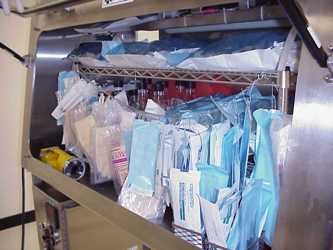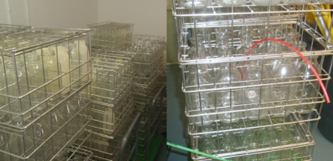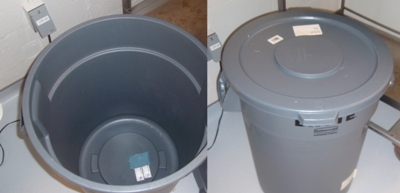Biological Indicators
1-log = 90%
2-log = 99%
3-log = 99.9%
4-log = 99.99%
5-log = 99.999%
6-log = 99.9999%
(sterilization level reduction)
Biological Indicators (BIs), most commonly inoculated with 106 bacterial spores and referred to as spore strips, are used to challenge the efficacy of a decontamination/sterilization cycle as they are considered among the hardest organisms to kill. Sterilization, often referred to as the 6-log reduction of organisms occurs when there is a million-fold reduction in living organisms which is why these spore strips generally consist of approximately 1 million bacterial spores.
To challenge the decontamination/sterilization cycle, BIs are placed in hard to reach areas throughout the space being decontaminated; rooms, isolators, biological safety cabinets, etc. Once the decontamination has been completed, the BIs are dropped into growth media using aseptic technique. If the biological indicator does not produce growth within the media tube after the incubation period (typically 36 hours), the decontamination/sterilization cycle is deemed to be successful.
Chlorine Dioxide Gas Biological Indicators:
ClorDiSys biological indicators consisting of 106 Geobacillus stearothermophilus or bacillus atrophaeus spores inoculated on a paper substrate and wrapped in tyvek. We have found these to be the most reliable and repeatable BIs available for chlorine dioxide gas. The tyvek creates a barrier to prevent the spores from escaping, and prevents other organisms from entering post-decontamination allowing the BIs to be handled and transported easily. The chlorine dioxide gas molecule is small enough however, to permeate the tyvek and kill the spores inside. BIs and media can be purchased through the manufacturer or directly through us.
Biological Indicator Locations:
As BIs should always be used to challenge decontamination/sterilization cycles, they must be placed in challenging areas. ClorDiSys always uses BIs with a population of 106 spores (that's 1 million spores!) to test our decontamination cycles, even for our "challenge" locations. Below are some of the more challenging locations where BIs have been placed during chlorine dioxide gas decontaminations. All of these challenge location BIs exhibited 6-log sterilization level kill using our standard cycle.
 In Packed Storage Rooms(BI was placed at the bottom of the closest trash can) |
 Inside Packed Isolators(Over 30 BIs were placed inside) |
 Inside Water Bottles(BI at bottom of middle bottle of middle rack) |
 Inside Closed Trash Can |
 Inside Closed Cabinets(cabinet on right is closed) |
 Inside Closed Drawer(Drawer on right is closed) |
 Underneath Dust(such as in HEPA filters) |
 In HEPA Filter(BI between pleats of HEPA Filter) |
 Underneath Printers and Other Equipment |
 In Stacks of Filtered Cage Lids(Blue tape on right corresponds to BIs shown in left image) |
